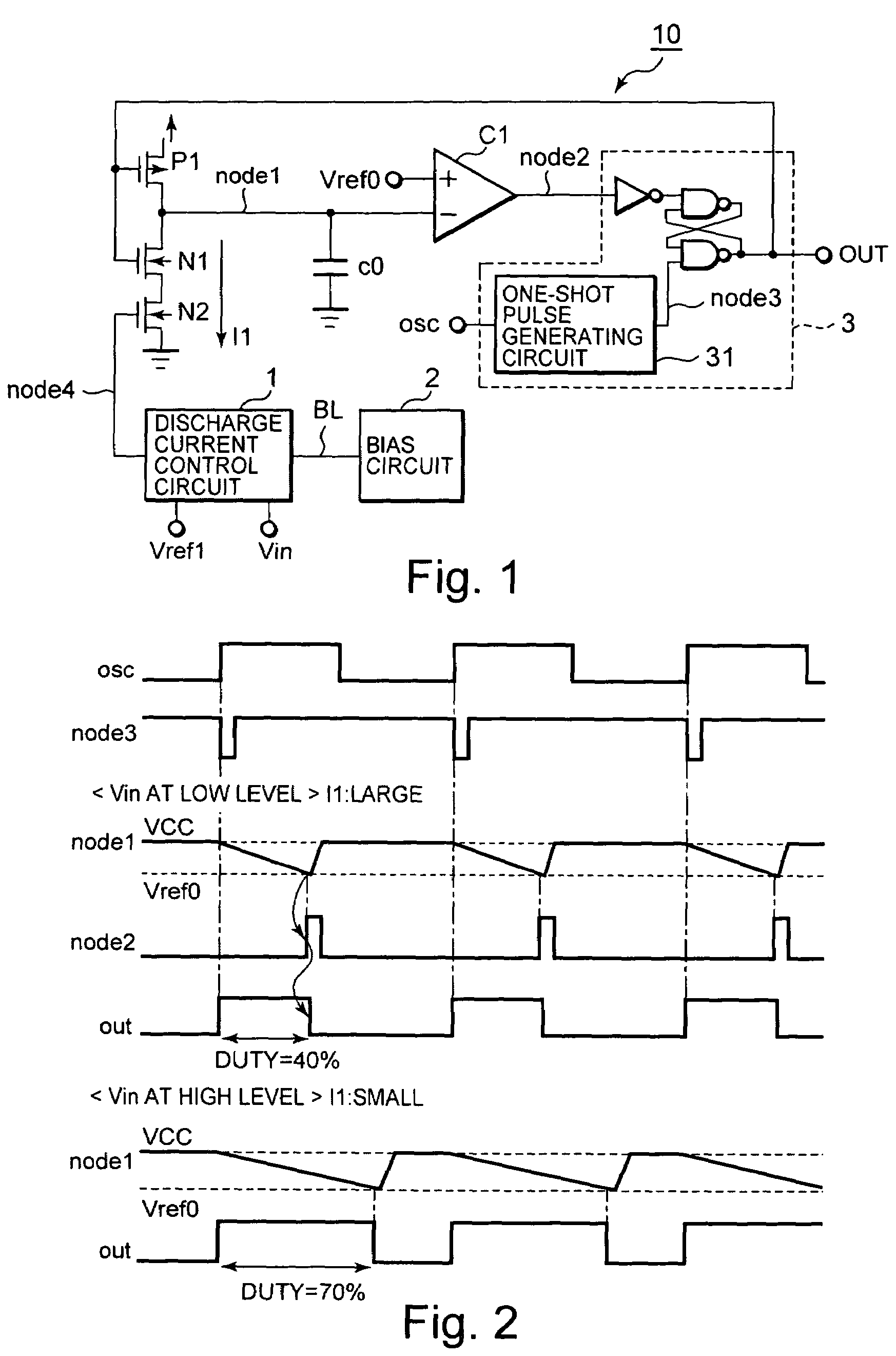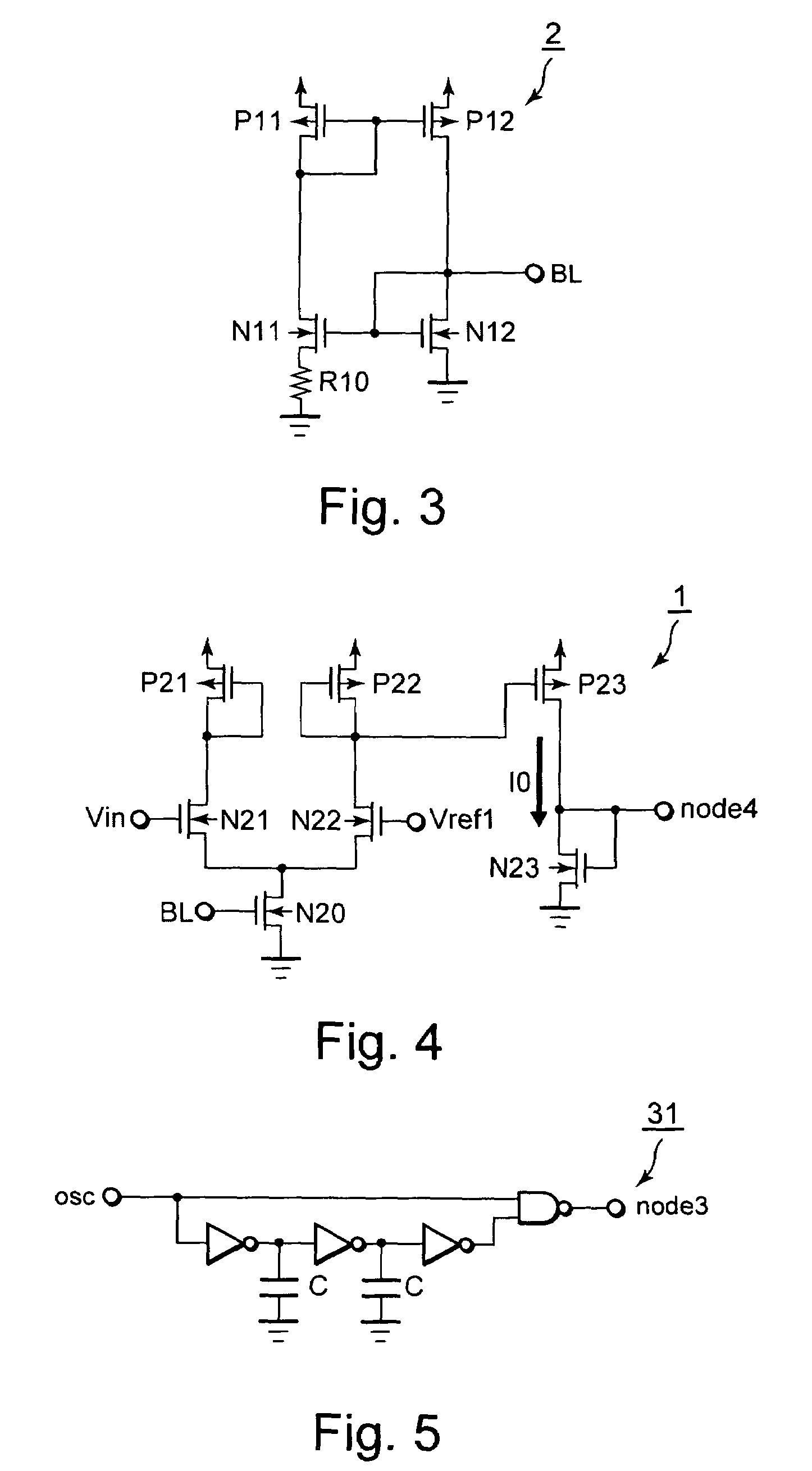Pulse width modulation circuit
a technology of width modulation and circuit, applied in pulse technique, multi-stage water/sewage treatment, electric controllers, etc., can solve the problems of increasing layout size, increasing power consumption, and increasing power consumption, so as to reduce layout size, reduce power consumption, and low voltage operation margin
- Summary
- Abstract
- Description
- Claims
- Application Information
AI Technical Summary
Benefits of technology
Problems solved by technology
Method used
Image
Examples
first preferred embodiment
[0031]FIG. 1 is a diagram showing a configuration of a pulse width modulation (PWM) circuit according to a first embodiment of the present invention. The PWM circuit 10 is comprised of a PMOS transistor P1 for charging a node1, a NMOS transistor N1, N2 coupled serially to the PMOS transistor P1 for discharging stored charge on the node1 (an inverter comprised of a pair of the PMOS transistor P1 and the NMOS transistor N1 configures a charge and discharge means), a capacitor C0 coupled to the Node1, a comparator C1 that receives an input signal on the node1 and a reference signal Vref0, a discharge current control circuit that controls a fall-down time of a potential level of the node 1 by controlling a discharging current I1, a bias circuit 2 for generating a constant current and a PWM control circuit 3 that generates ON / OFF pulse signal for turning on and off the PMOS transistor P1 and the NMOS transistor N1 from a oscillator signal OSC and an output signal of the comparator C1 to ...
second preferred embodiment
[0050]FIG. 6 is a diagram showing a configuration of a PWM circuit according to a second embodiment of the present invention. The PWM circuit 20 is different as to comprising a NMOS transistor N3 coupled parallel to the NMOS transistor N2. The gate of the NMOS transistor N3 is coupled to the output BL of the bias circuit 2 and the drain is commonly coupled to the source of the NMOS transistor N1, and the source of it is coupled to the ground.
[0051]The operation of this PWM circuit will now be explained below. The basic operation of the circuit is similar to that of the first embodiment. In this embodiment, discharge current I1 is the sum of the current I3 of the NMOS transistor N3 and the current I2 of the NMOS transistor N2.
[0052]When a dimension ratio of the NMOS transistor N12 of the bias circuit 2 and that of the NMOS transistor N3 of the PWM circuit 20 is in a predetermined ratio (e.g. 1:n), the relation I3=n*If is satisfied (the If is a constant current of the NMOS transistor ...
third preferred embodiment
[0054]FIG. 7 is a diagram showing a configuration of a PWM circuit according to a third embodiment of the present invention. The PWM circuit 30 comprises a transfer gate 4 with PMOS transistor P1 and NMOS transistor N4 instead of the transistor P1 of the second preferred embodiment. The transfer gate 4 is controlled by the output signal OUT of the PWM control circuit 3. The circuit 30 also comprises an operational amplifier A1 which is configured as voltage follower with the input of reference voltage Vref2, the output of which is coupled to a terminal T1 of the transfer gate 4.
[0055]The operation of the PWM circuit 30 of the third preferred embodiment will now be described. The basic operation is similar to that of the first preferred embodiment, so only the difference of the operation will be described.
[0056]When the signal OSC is “low”, the transfer gate 4 is “on” and the node1 is charged up to the output level vref2 of the operational amplifier A1. The voltage level of Vref2 is ...
PUM
 Login to View More
Login to View More Abstract
Description
Claims
Application Information
 Login to View More
Login to View More - R&D
- Intellectual Property
- Life Sciences
- Materials
- Tech Scout
- Unparalleled Data Quality
- Higher Quality Content
- 60% Fewer Hallucinations
Browse by: Latest US Patents, China's latest patents, Technical Efficacy Thesaurus, Application Domain, Technology Topic, Popular Technical Reports.
© 2025 PatSnap. All rights reserved.Legal|Privacy policy|Modern Slavery Act Transparency Statement|Sitemap|About US| Contact US: help@patsnap.com



